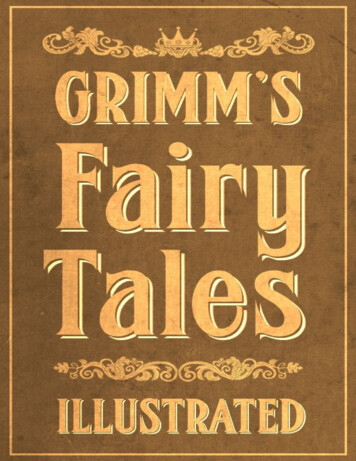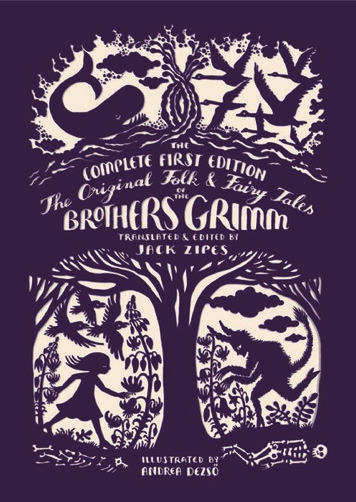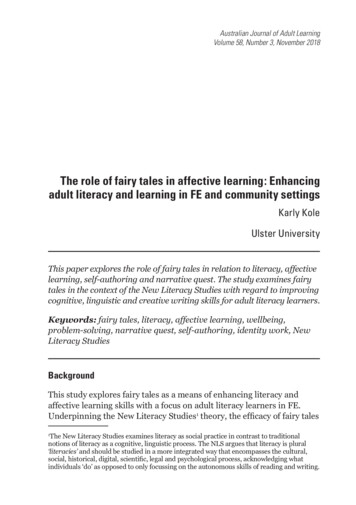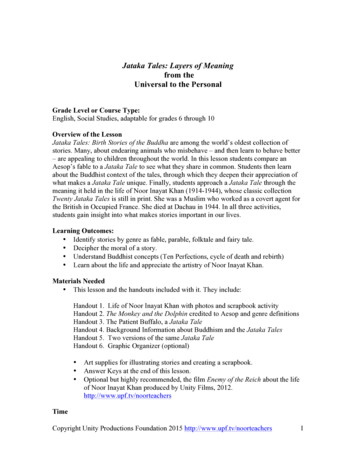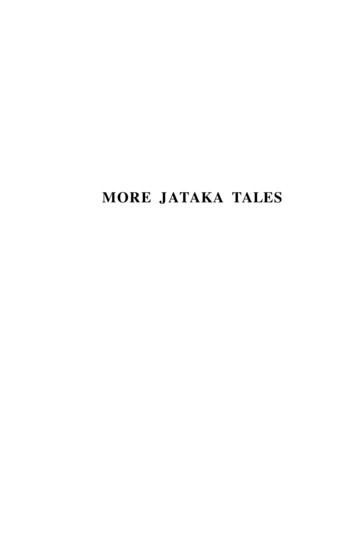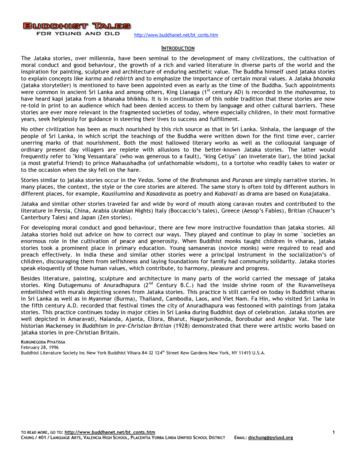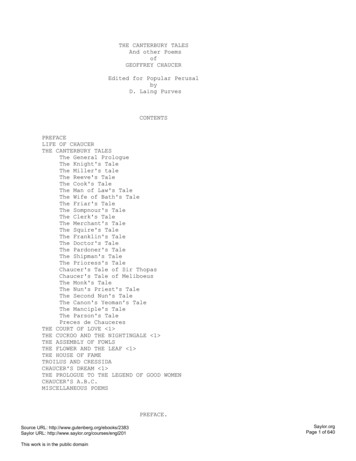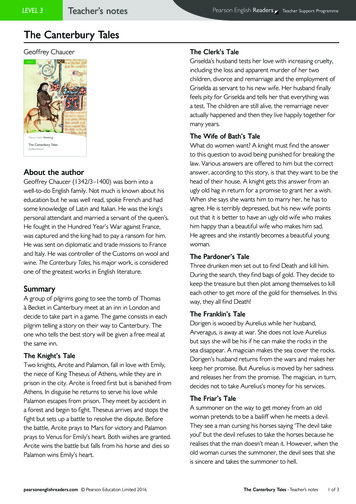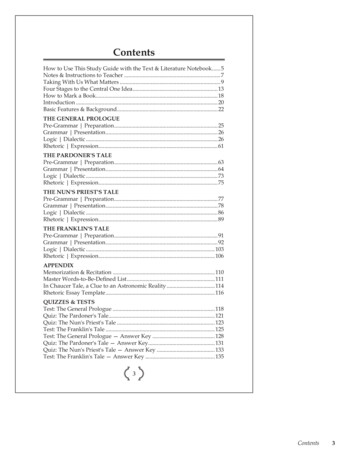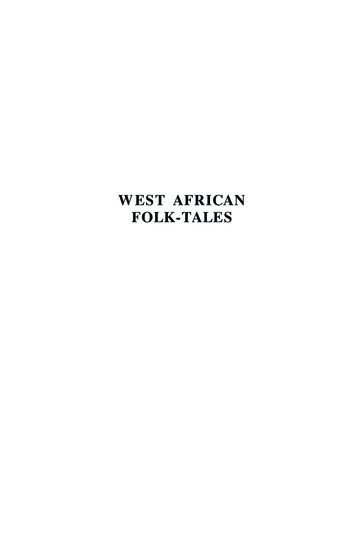
Transcription
TheCLASSICFAIRY TALESE D I T E D BY M A R I A T A T A RA NORTONCRITICALEDITION
THE CLASSIC FAIRY TALESThe cultural resilience of fairy tales is incontestable. Surviving over the cen turies and thriving in a variety of media, fairy tales continue to enrich our imag inations and shape -our lives. T h i s Norton Critical Edition of The Classic FairyTales examines the genre, its cultural implications, and its critical history. T h eeditor has gathered fairy tales from around the world to reveal the range andplay of these stories over time.The Classic Fairy Tales focuses on six different tale types: "Little Red RidingHood," "Beauty and the Beast," "Snow White," "Cinderella," "Bluebeard," and"Hansel and Gretel." It includes multicultural variants of these tales, along withsophisticated literary rescriptings. Each tale type is preceded by an introduc tion, and annotations are provided throughout. Also included in this collectionof over forty stories are tales by Hans Christian Andersen and Oscar W i l d e ."Criticism" collects twelve essays that interrogate different aspects of fairytales by exploring their social origins, historical evolution, psychologicaldynamics, and engagement with issues of gender and national identity. BrunoBettelheim, Robert Darnton, Sandra M . Gilbert and Susan Gubar, Karen E.Rowe, Marina Warner, Zohar Shavit, Jack Zipes, Donald Haase, M a r i a Tatar,Antti Aarne, and Vladimir Propp provide critical overviews.A Selected Bibliography is included.THE S E R I E S : Each Norton Critical Edition includes an authoritativetext, contextual and source materials, and a wide range of interpretations—from contemporary perspectives to the most current critical theory—as well asa bibliography and, in most cases, a chronology of the author's life and work.ABOUTC O V E R P A I N T I N G : The Enchanted Prince, by Maxfield Parrish. Reproduced by per mission of Maxfield Parrish Family Trust/Licensed by ASAP and VAGA,N Y C / C o u r t e s y American Illustrated Gallery, N Y CISBN 0 - 3 9 3 - 9 7 2 7 7 - 1NEW YORK LONDON
TheEditorMARIA TATAR is the author of The Hard Facts of theGrimms' Fairy Tales, Off with Their Heads! Fairy Talesand the Culture of Childhood, and Lustmord: Sexual Vi olence in Weimar Germany. She holds the John L. Loebchair for Germanic Languages and Literatures at Har vard University, where she teaches courses on Germancultural studies, folklore, and children's literature.
W.W.N O R T O NAlso&C O M P A N Y ,I N C .PublishesT H E NORTON ANTHOLOGY OF AFRICAN AMERICAN LITERATUREedited by Henry Louis Gates Jr. and Nellie Y McKay et al.T H E NORTON ANTHOLOGY OF AMERICAN LITERATUREedited by Nina Baym et al.T H E NORTON ANTHOLOGY OF CONTEMPORARY FICTIONedited by R. V. Cassill and Joyce Carol OatesT H E NORTON ANTHOLOGY OF ENGLISH LITERATUREedited by M. H. Abrams and Stephen Greenblatt et al.T H E NORTON ANTHOLOGY OF LITERATURE BY WOMENedited by Sandra M. Gilbert and Susan GubarTHE NORTON ANTHOLOGY OF MODERN POETRYedited by Richard Ellmann and Robert O'ClairTHE NORTON ANTHOLOGY OF POETRYedited by Margaret Ferguson et al.T H E NORTON ANTHOLOGY OF SHORT FICTIONedited by R. V. Cassill and Richard BauschT H E NORTON ANTHOLOGY OF WORLD MASTERPIECESedited by Sarah Lawall et al.T H E NORTON FACSIMILE OF THE FIRST FOLIO OF SHAKESPEAREprepared by Charlton HinmanT H E NORTON INTRODUCTION TO LITERATUREedited by Jerome Beaty and J. Paul HunterT H E NORTON INTRODUCTION TO THE SHORT NOVELedited by Jerome BeatyT H E NORTON READERedited by Linda H. Peterson, John C. Brereton, and Joan E. HartmanT H E NORTON SAMPLERedited by Thomas CooleyTHE NORTON SHAKESPEARE, BASED ON THE OXFORD EDITIONedited by Stephen Greenblatt et al.For a complete list of Norton Critical Editions, visit uson the World Wide Web rn
AN O R T O NCRITICALEDITIONTHECLASSIC FAIRY TALES âézTEXTSCRITICISMEditedbyMARIA TATARHARVARD U N I V E R S I T YW W NORTON & COMPANY New York London
For Lauren and DanielCopyright 1999 by W. W. Norton & Company, Inc.All rights reserved.Printed in the United States of America.First Edition.The text of this book is composed in Electra with the display set in BernhardModem. Composition by PennSet, Inc. Book design by Antonina Krass.Cover illustration: The Enchanted Prince, reproduced by permission of MaxfieldParrish Family Trust/Licensed by ASAP and VAGA, NYC /Courtesy AmericanIllustrated Gallery, NYC.Library of Congress Cataloging-in-Publication DataThe classic fairy tales : texts, criticism / edited by Maria Tatar,p. cm. — (Norton critical edition)Includes bibliographical references.ISBN 0-393-97277-1 (pbk.)1. Fairy tales — History and criticism. I. Tatar, Maria M., 1 9 4 5 GR550.C57 1998385.2-dc2198-13552W. W. Norton & Company, Inc., 500 Fifth Avenue, New York, N.Y. 10110www.wwnorton.comW. W. Norton & Company Ltd., Castle House, 75/76 Wells Street,London W I T 3QT6 7 890
ContentsIntroductionixThe Texts of The Classic Fairy Tales1INTRODUCTION: Little Red Riding HoodThe Story of GrandmotherCharles Perrault Little Red Riding HoodBrothers Grimm Little Red CapJames Thurber T h e Little Girl and the WolfItalo Calvino T h e False GrandmotherChiang Mi Goldflower and the BearRoald Dahl Little Red Riding Hood and the WolfRoald Dahl The Three Little Pigs31011131617192122INTRODUCTION: Beauty and the Beast 25Jeanne-Marie Leprince de Beaumont Beauty and theBeast 32Giovanni Francesco Straparola T h e Pig KingBrothers Grimm T h e Frog King, or Iron HeinrichAngela Carter T h e Tiger's BrideUrashima the FishermanAlexander Afanasev The Frog PrincessThe Swan Maiden424750666872INTRODUCTION: Snow WhiteGiambattista Basile T h e Young SlaveBrothers Grimm Snow WhiteLasair Gheug, the King of Ireland's DaughterAnne Sexton Snow White and the Seven Dwarfs7480839096INTRODUCTION: CinderellaYeh-hsienCharles Perrault DonkeyskinBrothers Grimm CinderellaJoseph Jacobs CatskinThe Story of the Black Cow101107109117122125
viCONTENTSLin Lan CinderellaThe Princess in the Suit of Leather127131INTRODUCTION: BluebeardCharles Perrault BluebeardBrothers Grimm Fitcher's BirdBrothers Grimm T h e Robber BridegroomJoseph Jacobs Mr. FoxMargaret Atwood Bluebeard's Egg138144148151154156INTRODUCTION: Hansel and GretelBrothers Grimm Hansel and GretelBrothers Grimm T h e Juniper TreeJoseph Jacobs T h e Rose-TreeCharles Perrault Little ThumblingPippety PewJoseph Jacobs Molly Whuppie179184190197199206209INTRODUCTION: Hans Christian AndersenThe Little MermaidThe Little Match GirlThe Girl Who Trod on the LoafThe Red Shoes212216233235241INTRODUCTION: Oscar WildeThe Selfish GiantThe Happy PrinceThe Nightingale and the Rose246250253261Criticism267Bruno Bettelheim [The Struggle for Meaning]269Bruno Bettelheim "Hansel and Gretel" 273Robert Darnton Peasants Tell Tales: The Meaning ofMother Goose 280Sandra M. Gilbert and Susan Gubar [Snow White andHer Wicked Stepmother] 291Karen E. Rowe To Spin a Yarn: The Female Voice inFolklore and Fairy Tale 297Marina Warner The Old Wives' Tale 309ZoharShavit se—"Little Red Riding Hood" 317Jack Zipes Breaking the Disney Spell332
CONTENTSDonald Haase Yours, Mine, or Ours? Perrault,the Brothers Grimm, and the Ownership ofFairy Tales 353Maria Tatar Sex and Violence: The Hard Core ofFairy Tales 364Antti Aarne and Stith Thompson From The Types ofthe Folktale: A Classification and Bibliography 373Vladimir Propp Folklore and Literature From Morphology of the FolktaleThe Method and Material Thirty-One Functions Propp's Dramatis PersonaeSelected Bibliography378382382386387389
IntroductionFairy tales, Angela Carter tells us, are not "unique one-offs," and theirnarrators are neither "original" nor "godlike" nor "inspired." To the con trary, these stories circulate in multiple versions, reconfigured by each tell ing to form kaleidoscopic variations with distinctly different effects. Whenwe say the word "Cinderella," we are referring not to a single text but toan entire array of stories with a persecuted heroine who may respond toher situation with defiance, cunning, ingenuity, self-pity, anguish, or grief.She will be called Yeh-hsien in China, Cendrillon in Italy, Aschenputtelin Germany, and Catskin in England. Her sisters may be named One-Eyeand Three-Eyes, Anastasia and Drizella, or she may have just one sisternamed Haloek. Her tasks range from tending cows to sorting peas to fetch ing embers for a fire.Although many variant forms of a tale can now be found between thecovers of books and are attributed to individual authors, editors, or com pilers, they derive largely from collective efforts. In reflecting on the originsof fairy tales, Carter asks us to consider: "Who first invented meatballs? Inwhat country? Is there a definitive recipe for potato soup? Think in termsof the domestic arts. This is how I make potato soup.' "' The story of LittleRed Riding Hood, for example, can be discovered the world over, yet itvaries radically in texture and flavor from one culture to the next. Even ina single culture, that texture or flavor may be different enough that a lis tener will impatiently interrupt the telling of a tale to insist "That's not theway I heard it." In France, Little Red Riding Hood and her grandmotherare devoured by the wolf. The Grimms' version, by contrast, stages a rescuescene in which a hunter intervenes to liberate Red Riding Hood and hergrandmother from the belly of the wolf. Caterinella, an Italian Red RidingHood, is invited to dine on the teeth and ears of her grandmother by amasquerading wolf. A Chinese "Goldflower" manages to slay the beast whowants to devour her by throwing a spear into his mouth. Local color oftenaffects the premises of a tale. In Italy, the challenge facing one heroine isnot spinning straw into gold but downing seven plates of lasagna.Virtually every element of a tale, from the name of the hero or heroinethrough the nature of the beloved to the depiction of the villain, seemssubject to change. In the British Isles, Cinderella goes by the name ofCatskin, Mossycoat, or Rashin-Coatie. The mother of one Italian "Beauty"pleads with her daughter to marry a pig, while another mother runs inter ference for a snake. In Russia, the cannibalistic witch in the forest has ahut set on chicken legs surrounded by a fence with posts made of stacked1. Angela Carter, ed., The Virago Book of Fairy Tales (London: Virago Press, 1990) x.IX
INTRODUCTIONXhuman skulls. Rumpelstiltskin is also known as Titelirure, Ricdin-Ricdon,Tom Tit Tot, Batzibitzili, Panzimanzi, and Whuppity Stoorie.While there is no "original" version of "Cinderella" or "SleepingBeauty," there is a basic plot structure (what folklorists refer to as a "taletype") that appears despite rich cultural variation. "Beauty and the Beast,"for example, according to the tale-type index compiled by the Finnishfolklorist Antti Aarne and refined by the American folklorist Stith Thomp son, has the following episodic structure:I.II.III.IV.V.The monster as husbandDisenchantment of the monsterLoss of the husbandSearch for the husbandRecovery of the husbandWhile the monster as husband is a structural constant, the monster itselfmay (and does) take the form of virtually any beast—a goat, a mouse, ahedgehog, a crocodile, or a lion. The search for the husband may requirethe heroine to cover vast tracts of land in iron shoes, to sort out peas fromlentils in an impossibly short time, or simply to wish herself back to themonster's castle. Despite certain limitations, the tale-type index is a con venient tool for defining the stable core of a story and for identifying thosefeatures subject to local variation.Telling fairy tales has been considered a "domestic art" at least sincePlato in the Gorgias referred to the "old wives' tales" told by nurses toamuse and to frighten children. Although virtually all of the national col lections of fairy tales compiled in the nineteenth century were the work ofmen, the tales themselves were ascribed to women narrators. As early asthe second century A.D., Apuleius, the North African author of The GoldenAss, had designated his story of "Cupid and Psyche" (told by a drunkenand half-demented old woman) as belonging to the genre of "old wives'tales." The Venetian Giovanni Francesco Straparola claimed to have heardthe stories that constituted his Facetious Nights of 1550 "from the lips of. . . lady storytellers" and he embedded those stories in a narrative framefeaturing a circle of garrulous female narrators. Giambattista Basile's sev enteenth-century collection of Neapolitan tales, The Pentamerone, also haswomen storytellers—quick-witted, gossipy old crones who recount "thosetales that old women tell to amuse children." The renowned Tales ofMother Goose by Charles Perrault were designated by their author as oldwives' tales, "told by governesses and grandmothers to little children." Andmany of the most expansive storytellers consulted by the Grimms werewomen—family friends or servants who had at their disposal a rich reper toire of folklore.The association of fairy tales with the domestic arts and with old wives'tales has not done much to enhance the status of these cultural stories.2342. Marina Warner, From the Beast to the Blonde: On Fairy Tales and Their Tellers (New York:Farrar, Straus and Giroux, 1994) 36.3. The Pentamerone, trans. Benedetto Croce, ed. N. M. Penzer (John Lane: The Bodley Head,1932) 9.4. Charles Perrault, "Préface," Contes en vers (1694; reprint, Paris: Gallimard, 1981) 50.
xiINTRODUCTION"On a par with trifles," Marina Warner stresses, " 'mere old wives' tales'carry connotations of error, of false counsel, ignorance, prejudice and fal lacious nostrums—against heartbreak as well as headache; similarly 'fairytale,' as a derogatory term, implies fantasy, escapism, invention, the unre liable consolations of romance."Although fairy tales are still arguably the most powerfully formative talesof childhood and permeate mass media for children and adults, it is notunusual to find them deemed of marginal cultural importance and dis missed as unworthy of critical attention. Yet the staying power of thesestories, their widespread and enduring popularity, suggests that they mustbe addressing issues that have a significant social function—whether criti cal, conservative, compensatory, or therapeutic. In a study of mass-producedfantasies for women, Tania Modleski points out that genres such as thesoap opera, the Gothic novel, and the Harlequin romance "speak to veryreal problems and tensions in women's lives. The narrative strategies whichhave evolved for smoothing over these tensions can tell us much abouthow women have managed not only to live in oppressive circumstancesbut to invest their situations with some degree of dignity." Fairy tales reg ister an effort on the part of both women and men to develop maps forcoping with personal anxieties, family conflicts, social frictions, and themyriad frustrations of everyday life.Trivializing fairy tales leads to the mistaken conclusion that we shouldsuspend our critical faculties while reading these "harmless" narratives.While it may be disturbing to hear voices disavowing the transformativeinfluence of fairy tales and proclaiming them to be culturally insignificant,it is just as troubling to find fairy tales turned into inviolable cultural icons.The Grimms steadfastly insisted on the sacred quality of the fairy tales theycollected. Their Nursery and Household Tales, they asserted, made an effortto capture the pure, artless simplicity of a people not yet tainted by thecorrupting influences of civilization. "These stories are suffused with thesame purity that makes children appear so marvelous and blessed," Wilhelm Grimm declared in his preface to the collection. Yet both brothersmust also have recognized that fairy tales were far from culturally innocent,for they extolled the "civilizing" power of the tales and conceived of theircollection as a "manual of manners" for children.The myth of fairy tales as a kind of holy scripture was energeticallypropagated by Charles Dickens, who brought to the literature of childhoodthe same devout reverence he accorded children. Like the Grimms, Dick ens hailed the "simplicity," "purity," and "innocent extravagance" of fairytales, yet also praised the tales as powerful instruments of constructive so cialization: "It would be hard to estimate the amount of gentleness andmercy that has made its way among us through these slight channels. Forebearance, courtesy, consideration for the poor and aged, kind treatment of5675. Warner, Beast 19. (Excerpted below, p. 309.)6. Tania Modleski, Loving with a Vengeance: Mass-Produced Fantasies for Women (Hamden,Conn.: Archon Books, 1982) 15.7. From Jacob and Wilhelm Grimms' "Preface," Nursery and Household Tales, 1st éd., 2d ed.,trans. Maria Tatar, in Maria Tatar, The Hard Facts of the Grimms' Fairy Tales (Princeton:Princeton UP, 1978) 206, 207.
xiiINTRODUCTIONanimals, the love of nature, abhorrence of tyranny and brute force—manysuch good things have been first nourished in the child's heart by thispowerful aid."Even in 1944, when Allied troops were locked in combat with Germansoldiers, W. H. Auden decreed the Grimms' fairy tales to be "among thefew indispensable, common-property books upon which Western culturecan be founded." "It is hardly too much to say," he added, "that these talesrank next to the Bible in importance." Like the devaluation of fairy tales,the overvaluation of fairy tales promotes a suspension of critical facultiesand prevents us from taking a good, hard look at stories that are so obviouslyinstrumental in shaping our values, moral codes, and aspirations. The rev erence brought by some readers to fairy tales mystifies these stories, makingthem appear to be a source of transcendent spiritual truth and authority.Such a mystification promotes a hands-off attitude and conceals the factthat fairy tales, like "high art," are squarely implicated in the complex, yetnot impenetrable, symbolic codes that permeate our cultural stories.Despite efforts to deflect critical attention from fairy tales, the storiesthemselves have attracted the attention of scholars in disciplinary cornersranging from psychology and anthropology through religion and history tocultural studies and literary theory. Every culture has its myths, fairy tales,and fables, but few cultures have mobilized as much critical energy as hasours of late to debate the merits of these stories. Margaret Atwood, whosepersonal and literary engagement with fairy tales is no secret, has writtenvividly about her childhood encounter with an unexpurgated version ofGrimms' Fairy Tales: "Where else could I have gotten the idea," she asserts,"so early in life, that words can change you?" Atwood's phrasing is mag nificently ambiguous, referring on one level to the transformative spellscast on fairy-tale characters, but also implying that fairy tales can both shapeour way of experiencing the world and endow us with the power to restruc ture our lives. As Stephen Greenblatt has observed, "the work of art is notthe passive surface on which . . . historical experience leaves its stamp butone of the creative agents in the fashioning and refashioning of this expe rience." As we read fairy tales, we simultaneously evoke the cultural ex perience of the past and allow it to work on our consciousness even as wereinterpret and reshape that experience.Carolyn Heilbrun has also addressed the question of how the storiescirculating in our culture regulate our lives and fashion our identities:8912Let us agree on this: that we live our lives through texts. These maybe read, or chanted, or experienced electronically, or come to us, likethe murmurings of our mothers, telling us of what conventions de8. Charles Dickens, "Frauds on the Fairies," in Household Words: A Weekly journal (New York:McElrath and Barker, 1854) 97.9. W. H. Auden, "In Praise of the Brothers Grimm," New York Times Book Review, 12 November1944, 1.1. Margaret Atwood, "Grimms' Remembered," in Donald Haase, ed., The Reception of Grimms'Fairy Tales: Responses, Reactions, Revisions (Detroit: Wayne State UP, 1993) 292.2. Stephen Greenblatt, "Introduction," Representing the English Renaissance, ed. StephenGreenblatt (Berkeley: U of California P, 1988) viii.
xiiiINTRODUCTIONmand. Whatever their form or medium, these stories are what haveformed us all, they are what we must use to make our new fictions. . . Out of old tales, we must make new lives.3Heilbrun endorses the notion of appropriating, revising, and revitalizing"old tales" in order to produce new social discourses that can, in turn,refashion our lives.How we go about mobilizing fairy tales to help us form new social rolesand identities is a hotly contested question. Some advocate the recupera tion and critique of the classic canon; others have called for the revival of"heretical" texts (stories repressed and suppressed from cultural memory)and the formation of a new canon; still others champion rewriting the oldtales or inventing new ones. This volume furnishes examples of each ofthese strategies, providing "classic" versions of specific tale types side byside with less well known versions from other cultures and inspired literaryefforts to recast the tales. These projects for reclaiming folkloric legaciesare not unproblematic, and they have each come under fire for failing toprovide the answer to that perennial question of what makes an ideal cul tural story.For some observers, the classic canon of fairy tales is so hopelessly ret rograde that it is futile to try to rehabilitate it. Andrea Dworkin refuses tocountenance the possibility of preserving tales that were more or less forcedupon us and that have been so effective in promoting stereotypical genderroles:We have not formed that ancient world [of fairy tales]—it has formedus. We ingested it as children whole, had its values and consciousnessimprinted on our minds as cultural absolutes long before we were infact men and women. We have taken the fairy tales of childhood withus into maturity, chewed but still lying in the stomach, as real identity.Between Snow-white and her heroic prince, our two great fictions, wenever did have much of a chance. At some point the Great Dividetook place: they (the boys) dreamed of mounting the Great Steed andbuying Snow-white from the dwarfs; we (the girls) aspired to becomethat object of every necrophiliac's lust—the innocent, victimized Sleep ing Beauty, beauteous lump of ultimate, sleeping good.4Yet for every critic who is convinced that we need to sound the tocsinand make fairy tales off-limits to children, there is one who celebrates theliberating energy and revolutionary edge of fairy tales. Alison Lurie, forexample, sees the tales as reflecting a commendable level of gender equal ity, along with a power asymmetry tilted in favor of older women:These stories suggest a society in which women are as competent andactive as men, at every age and in every class. Gretel, not Hansel,defeats the Witch; and for every clever youngest son there is a youngestdaughter equally resourceful. The contrast is greatest in maturity,3. Carolyn Heilbrun, "What Was Penelope Unweaving?" in Hamlet's Mother and Other Women(New York: Columbia UP, 1990) 109.4. Andrea Dworkin, Woman-Hating (New York: Dutton, 1974) 32-33.
xivINTRODUCTIONwhere women are often more powerful than men. Real help for thehero or heroine comes most frequently from a fairy godmother or wisewoman, and real trouble from a witch or wicked stepmother. . . . Toprepare children for women's liberation, therefore, and to protectthem against Future Shock, you had better buy at least one collectionof fairy tales.5Whom are we to believe? Andrea Dworkin, who contends that fairy talesperpetuate gender stereotypes, or Alison Lurie, who asserts that they un settle gender roles? Do we side with those who denounce fairy tales fortheir melodrama and violence or with the psychologist Bruno Bettelheim,who finds them crucial to a child's healthy mental development? MargaretAtwood would answer by saying "It depends." Astonished by reports thatGrimms' Fairy Tales was being denounced as sexist, she observed that onefinds in the volume "wicked wizards as well as wicked witches, stupidwomen as well as stupid men." "When people say 'sexist fairy tales,' " sheadded, "they probably mean the anthologies that concentrate on 'TheSleeping Beauty,' 'Cinderella,' and 'Little Red Riding Hood' and leave outeverything else. But in 'my' version, there are a good many forgetful orimprisoned princes who have to be rescued by the clever, brave, and re sourceful princess, who is just as willing to undergo hardship and risk herneck as are the princes engaged in dragon slaying and tower climbing."Few fairy tales dictate a single, univocal, uncontested meaning; most areso elastic as to accommodate a wide variety of interpretations, and theyderive their meaning through a process of engaged negotiation on the partof the reader. Just as there is no definitive version of "Little Red RidingHood," there is also no definitive interpretation of her story.Some versions of Little Red Riding Hood's story or Snow White's storymay appear to reenforce stereotypes; others may have an emancipatory po tential; still others may seem radically feminist. All are of historical interest,revealing the ways in which a story has adapted to a culture and beenshaped by its social practices. The new story may be ideologically corrector ideologically suspect, but it can always serve as the point of departurefor debate, critique, and dialogue. In this volume, I have tried to convey asense of the rich cultural archive behind stories that we tend to flatten outwith the monolithic labels "Little Red Riding Hood," "Snow White," or"Cinderella."Recovering fairy tales that have undergone a process of cultural sup pression or that have succumbed to cultural amnesia has been the missionof a number of folklorists in the past decades. Instead of reshaping canon ical fairy tales or trying to reinvent them, these collectors seek to fill in themany empty spaces on the shelves of our collective folkloric archive. Rose mary Minard's Womenfolk and Fairy Tales explicitly seeks to identify talesin which women are "active, intelligent, capable, and courageous humanbeings." While Minard succeeds in reviving some resourceful folklore her oines, many of the faces in her anthology are familiar ones. A Chinese RedRiding Hood, a Scandinavian Beauty, and a British wife of Bluebeard675. Alison Lurie, "Fairy Tale Liberation," New York Review of Books, 17 December 1970, 42.6. Atwood, "Grimms' Remembered," 291-92.7. Rosemary Minard, ed., Womenfolk and Fairy Tales (Boston: Houghton Mifflin, 1975) viii.
INTRODUCTIONXVmingle in her anthology with the more obscure Unanana, Kate Crackernuts, and Clever Manka.Like Minard, Ethel Johnston Phelps aims to collect tales that feature"active and courageous girls and women in the leading roles" for her vol ume Tatterhood and Other Tales. By contrast, Angela Carter's Virago Bookof Fairy Tales chooses texts for their historical interest, for the way in whichthey provide models of how women struggled, succeeded, and also some times failed in the challenges of everyday life. "I wanted to demonstratethe extraordinary richness and diversity of responses to the same commonpredicament—being alive—and the richness and diversity with which fem ininity, in practice, is represented in 'unofficial' culture: its strategies, itsplots, its hard work."Our own fairy-tale repertoire can now be said to consist of two competingtraditions. On the one hand, we have the classical canon of tales collectedby, among others, Joseph Jacobs in England, Charles Perrault in France,the Grimm brothers in Germany, and Alexander Afanasev in Russia. Onthe other hand, we have a rival tradition of heretical stories established byfolklorists who have sought to unearth buried cultural treasures and toconduct archaeological exercises designed to connect us with a subversivedimension of our collective past. In addition to this twin folkloric legacy,we have the reinventions of such authors as Hans Christian Andersen andOscar Wilde, who, in competing with the raconteurs of old, attempted tosupplant their narratives and to provide new cultural texts on which tomodel our lives.Hans Christian Andersen and Oscar Wilde can be seen as moving in animitative mode, attempting to capture the style and spirit of folk raconteursin their literary efforts. Yet their fairy tales, with their self-consciously artlessexpressions and calculated didactic effects, diverge dramatically from thetraditional tales of folk cultures. What both Andersen and Wilde seem tohave forgotten is that the folktale thrives on conflict and contrast, not onsentiment and pathos. P. L. Travers tellingly registers her response as achild to reading Andersen's fairy tales: "Ah, how pleasant to be manipu lated, to feel one's heartstrings pulled this way and that—twang, twang,again and again, longing, self-pity, nostalgia, remorse—and to let fall thefullsome tear that would never be shed for Grimm." Andersen wants toerase "the pagan world with its fortitude and strong contrasts." Still, An dersen's "Little Mermaid" reveals just how easily literary fairy tales canmutate into folklore, lending themselves to adaptation, transformation, andcritique in a variety of media and becoming part of our collective culturalawareness.Feminist writers have resisted the temptation to move in the imitativemode, choosing instead the route of critique and parody in their recastingsof tales. For Anne Sexton, for example, the history and wisdom of the pastembedded in fairy tales is less important than the construction of newcultural signposts for coping with "being aliv
The Editor MARIA TATAR is the author of The Hard Facts of the Grimms' Fairy Tales, Off with Their Heads! Fairy Tales and the Culture of Chil
